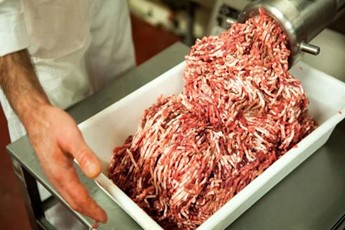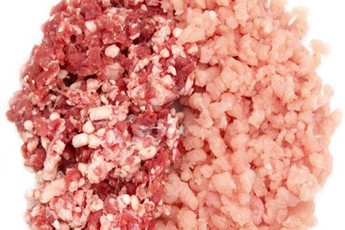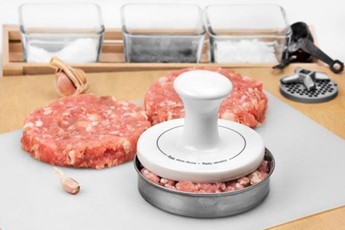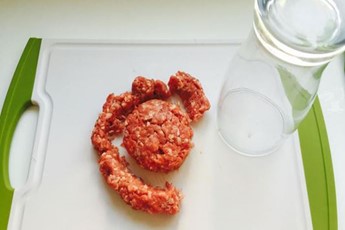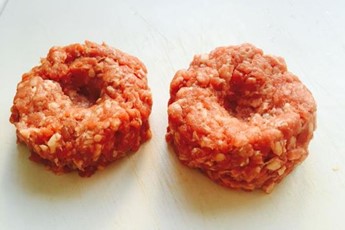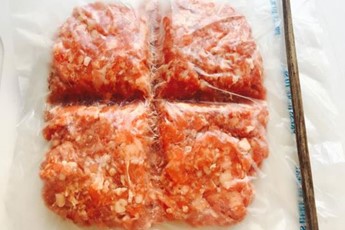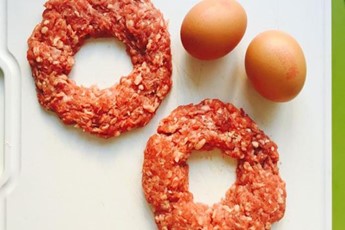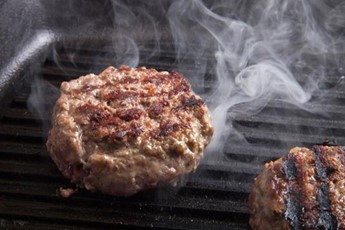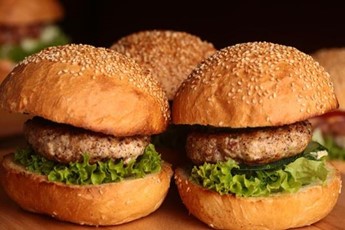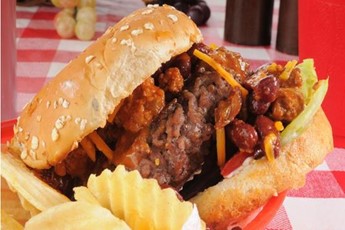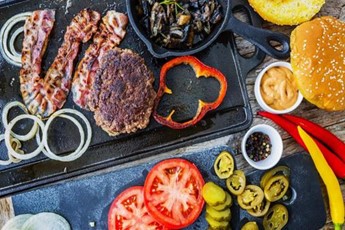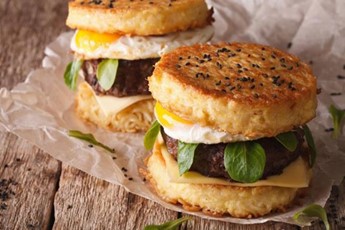The ultimate burger cooking tips, hacks and tricks

Check out these top tips to give your burger more of a delicious edge!
From how to choose the meat, to making the perfect patty shape, to cooking and topping to perfection, these tips and tricks will set you on the path to true burger glory.
Buy the best beef you can afford
For juicy burgers fat is key, and as cheap cuts tend to be fattier they’re a much better choice than leaner or more expensive cuts. Opt for high-quality aged meat – preferably organic and grass-fed. Brisket, chuck and short rib are all good.
Don’t buy mince, buy meat
Once you’ve chosen the meat unless the butcher already has a bespoke ground mince blend then ask them to grind it for you or use a home grinder. You’re looking for discernable threads of meat, not a meat paste.
Consider the fat content
A well-done burger tastes better if it’s fattier – around 40-45% – while a medium-cooked burger ideally needs at least 30% fat. For blue or rare burgers opt for leaner meat (10-20% fat) as fat doesn’t have time to render down while cooking.
When two meats collide
Mixing two types of mince such as beef and pork, beef and lamb, or even turkey and beef, creates 50/50 burgers that will make a tasty change from the norm.
Wet your hands
It’s much easier to work with raw mince if your hands are wet – it stops stickiness and eases the molding process.
Resist overworking the meat
When preparing burgers a light hand is a must. Overworking the meat squeezes out the natural juices and makes the meat denser, resulting in tougher patties.
How to flatten the patties
Burgers aren’t meatballs; they should be flat. Many chefs use the palm of their hands to get an even patty. For a more uniform look invest in a hamburger press, or save yourself some cash and use a reasonably deep circular lid from a jar or Tupperware. Put clingfilm across the inside of the lid, press some meat into it, remove any excess meat, flatten then tip out.
Image: Debra Waters/Lovefood.com
Get the shape right
Another way to get perfectly circular patties is to press some meat into round cookie cutters or even use the rim of a cup or glass.
Size doesn’t matter
The size of the patties you prepare depends on how hungry you are. There’s no right amount though the general consensus points to 5-6 oz (around 1/3 pound). Patties of equal size will cook more evenly however.
Image: Debra Waters/Lovefood.com
Put a thumb in it
This is an essential burger trick – making a shallow indent with your thumb in the middle of an uncooked patty prevents the middle of the patty from rising during cooking so the burger stays flat and offers a perfect platform for toppings.
Think about the meat’s temperature
It’s generally regarded as good practice to let chilled meat get up to room temperature before cooking it. This is to prevent the surface drying out when cold meat hits a hot grill, and it’s also more likely to result in a browned exterior and a more even cook.
Image: Debra Waters/Lovefood.com
Planning ahead?
If you’re feeding a crowd preparing the patties in advance will save time and trouble. Prepare the mince, stuff it in a freezer bag and flatten, then use the flat side of a chopstick to make indents in the meat to create four squares. Freeze and when needed remove from the bag and break the patties apart. Allow to thaw before cooking.
Season!
Seasoning is instrumental in bringing out the flavour of meat although purists won’t add anything apart from salt and pepper. Either add while making the mix (the preferred option) or sprinkle on top before cooking.
Secret seasonings
If you don’t want to add bulk such as chopped sautéed onions, mushrooms or herbs to the patty mix but you do want extra flavour then minced garlic or mustard are nifty ways to add oomph to burgers without affecting the texture.
Get fishy with it
Here’s another tip – adding a dash of fish sauce to red meat intensifies its flavour. Don’t have any? Try a few drops of Worcestershire sauce instead; it has anchovies in it.
Thwart cheese drippage
If cheese is an essential part of the burger experience for you and you don’t want to lose any to the grill, stuff your burger with it before cooking. Make a hole in the centre of a patty, crumble some cheese in, fold the meat over then cook. Bite in to reveal a pocket of unctuous melted cheese.
Image: Debra Waters/Lovefood.com
How about an eggy centre?
If you’re partial to an egg on top why not add an egg in your burger? Make a large patty and cut a hole in the center, place in a hot skillet (a flat surface is needed so this one’s not for the grill), cook for a minute then crack an egg into the centre, wait a few moments, flip and cook the remaining side.
Utilise leftover fat
If you’ve sautéed onions, garlic or mushrooms in butter beforehand use any leftover fat to cook the burgers – the meat will pick up the flavor.
Cooking utensils and how to use them
A spatula for pressing and flipping is a key utensil (preferably long-handled so no fingers get scorched), and tongs also come in handy, as does a basting brush. Use separate tools for raw and cooked meat.
What fat?
Many burger cooks argue that no fat is required to cook burgers as the patties will cook in the meat’s rendered fat. If you do decide to use some lightly coat the burgers with butter or beef fat (dripping). Olive oil just won’t cut it.
BBQ or stove?
That depends on your preferences – and the weather. Barbecued burgers are a quintessential summer food and it’s hard to recreate that distinctive smoky taste indoors. If cooking on the stove use a heavy cast iron griddle or skillet.
The heat should be smoking hot
Don’t be afraid to whack up the heat – it’s got to be medium to high, so at least 400°F (200°C) – and the pan needs to smoke slightly. If cooking over coals create a hot area to sear the burgers and a cooler spot for the patties to finish cooking without burning.
To baste or not to baste?
Take a leaf out of Gordon Ramsay’s book and baste away. He bastes burgers in salty butter throughout cooking, and uses sturdier buns that are able to absorb the butter. This method works better on a flat cooking surface than on a grill.
To press or not to press?
The jury remains out on whether to press, or smash, burgers during cooking. Some chefs are horrified by the thought, as pressing can squeeze out the meat juices and result in tough patties. But if, like countless others, you like a brown crust on your burger then press firmly with a spatula within the first few moments of cooking – only once and only on one side – to encourage the browning reaction and ultimately a meatier-tasting burger. Just don’t be tempted to keep doing it.
Keep flipping to a minimum
It’s a similar deal with flipping. Flipping away may look good but in reality burgers only need to be flipped once, or perhaps twice at most.
Rare, medium or well done?
When cooking on a gas BBQ or a stove heat levels differ depending on how you want the burger cooked. A blue or rare burger needs searing on a high heat and that’s about it, while medium to well done burgers cook better on a lower (but still hot) heat for a longer time.
Cooking on charcoal requires skill
The heat from an open grill such as a charcoal BBQ is harder to control but that smoky flavour is worth it. There are ways to encourage an even cook: create a ‘cooler’ area on the grill by moving the coals to one side once the coals are glowing and start to generate ash flame then grill before moving the patties to the cooler section. Then do as short-order cooks commonly do and cover each burger with a heat-resistant bowl – this allows the burger to cook through in its own mini oven.
For the right cheese melt
For the ideal cheese melt add a slice as soon as you’ve flipped the burger.
How to prevent meat shrinkage
Burgers dwarfed by the buns? The fattier the meat the more a burger will shrink; this is because the fat renders down during cooking. Lean meat is more likely to shrink if it’s cooked on too high a heat and for too long. The answer? Anticipate shrinkage by making fatty patties bigger than you need and cook lean patties on a medium heat.
Rest the meat
This is so important – resting meat allows muscle fibres to relax and prevents the juices from escaping after the meat is cut or bit into. Five minutes, covered loosely in foil, is sufficient – either just the patty or the burger and bun, Five Guys-style.
Add more meat
Why the heck not? You can mix ground meats to create half-and-half patties (pork and beef, or beef and lamb), or incorporate finely chopped bacon, pepperoni or salami in the mince before cooking for added texture and flavour. Purists may disagree but others will love it. Alternatively, stack it on top: crispy bacon, slices of ham, steak or pastrami, a portion of slow cooked brisket or pulled pork, or a smothering of hot chilli (pictured above). Bring it on!
Make the bread toasty warm
Some people prefer theirs soft and doughy but a warm bun with a bit of crunch complements a soft juicy burger and is less likely to go soggy from meat juice. Baste lightly with melted butter and give each side 10 seconds on the grill while the meat is resting.
Pick your perfect buns…
This is subject to fierce debate but it largely comes down to personal taste – and the burger plays a part. Juicy burgers benefit from sturdy buns that can soak up meat liquor – brioche buns or ciabatta rolls are fit for purpose. Kaiser rolls, potato rolls, or plain soft white rolls/hamburger buns are an easy choice for home barbecues; for something a little different try pretzel rolls or even muffins.
…and cheese…
Like bread, the cheese you choose (if indeed you add it all) is a matter of taste. There are the timeless favourites: Cheddar, Monterey Jack and Swiss get top marks for flavour; blue cheese or Brie make for a more indulgent meal.
…and the toppings…
Here the world is your oyster, and you can even top burgers with fried oysters for a clever take on surf and turf. While some burger lovers scorn at the idea of piling toppings on a beautiful patty – managing some pickle and a slice of tomato at best – others will see it as a meaty blank canvas on which to rein down vegetables: fried onion, sautéed mushrooms, chopped peppers, grated carrot, sun dried tomato...
…and more toppings
Then there are the sauces: sour cream, BBQ sauce, ketchup, hot sauce. And herbs: basil, parsley, coriander. And nut butters – a layer of peanut butter creates a beef satay effect. And fried egg, meat slices, squid rings, and even fruit – for that sweet and savoury taste add pineapple.
Why stop at meat?
Who says a burger has to be red meat – turkey mince is a contender if you prefer something lighter. Or even meat at all? Try ‘meaty’ substitutes such as tuna or swordfish steaks, or halloumi cheese. If you like a patty, rustle up corncakes, bean burgers or lentil burgers. Grilled Portobello mushrooms or slices of chargrilled eggplant will appeal to veggie lovers.
Or bread?
Buns aren’t the only things you can sandwich a patty between. Diners on low-carb diets can place patties between sturdy iceberg lettuce leaves, two halves of a beef tomato, cooked Portobello mushrooms, or zucchini or eggplant slices. Then there’s the current trend for ramen noodles, spiralised vegetable or Thai sticky rice burgers. Other bread replacements include hash browns, or turn the burger concept on its head and use two meat patties as the bun with toppings sandwiched between.
What are your top burger tips? Let us know in the Comments below.
If you'd like to try some different burger recipes, you might enjoy these:
Comments
Be the first to comment
Do you want to comment on this article? You need to be signed in for this feature
